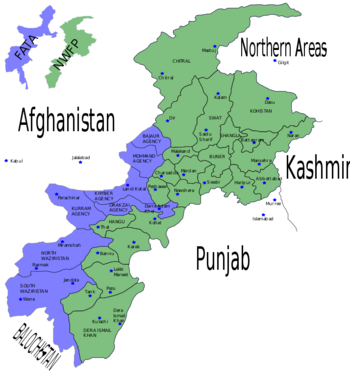Federally Administered Tribal Areas: Difference between revisions
John Leach (talk | contribs) (incorporated into KP six years ago; more to be done here) |
John Leach (talk | contribs) (a bit more; back later) |
||
| Line 1: | Line 1: | ||
{{subpages}} | {{subpages}} | ||
{{Image|NWFP FATA.png|right|350px|This map shows the location of FATA (blue) in relation to NWFP (green) and their neighbours. Broadly, the blue and green areas were combined as Khyber Pakhtunkwha in 2018. Within FATA are its seven semi-autonomous Tribal Agencies.}} | |||
The '''Federally Administered Tribal Area''' (FATA) was a semi-autonomous region of Pakistan that was created in 1947 and existed until 2018 when it was incorporated into the new province of [[Khyber Pakhtunkwha]], the former [[North-West Frontier Province]] (NWFP). The region consisted of seven Tribal agencies called: | |||
the [[Bajaur Agency]], | |||
the [[Mohmand Agency]], | |||
the [[Khyber Agency]], | |||
the [[Orakzai Agency]], | |||
the [[Kurram Agency]] | |||
and [[North Waziristan]] | |||
and [[South Waziristan]]. | |||
{{TOC|right}} | {{TOC|right}} | ||
Along [[Pakistan]]'s border with [[Afghanistan]] Pakistan exercises a measure of authority over '''Pakistan's Tribal Agencies'''.<ref name=NYTimes2002-12-26> | Along [[Pakistan]]'s border with [[Afghanistan]] Pakistan exercises a measure of authority over '''Pakistan's Tribal Agencies'''.<ref name=NYTimes2002-12-26> | ||
Revision as of 05:46, 13 February 2024
The Federally Administered Tribal Area (FATA) was a semi-autonomous region of Pakistan that was created in 1947 and existed until 2018 when it was incorporated into the new province of Khyber Pakhtunkwha, the former North-West Frontier Province (NWFP). The region consisted of seven Tribal agencies called: the Bajaur Agency, the Mohmand Agency, the Khyber Agency, the Orakzai Agency, the Kurram Agency and North Waziristan and South Waziristan.
Along Pakistan's border with Afghanistan Pakistan exercises a measure of authority over Pakistan's Tribal Agencies.[1] an unique administrative and political status from the British colonial rule in 1849. They were demarcated, in 1893, from Afghanistan by the Durand Line. Governance is by federal Political Agents and tribal elders, "while leaving the people with their traditions and internal independence. "[2]
Most of the population of the seven Tribal agencies are traditional, conservative muslims. The agencies are: the Bajaur Agency, the Mohmand Agency, the Khyber Agency, the Orakzai Agency, the Kurram Agency and North Waziristan and South Waziristan.
Ethnicity
According to the Pakistani government, the FATA contain about a dozen major tribes with several smaller tribes and sub-tribes. Utmankhel, Mohmand, Tarkani and Safi are the major tribes living in Bajaur and Mohmand. Afridi, Shilmani, Shinwari, Mulagori Orakzai are settled in Khyber and Orakzai while the FRs of Peshawar and Kohat are occupied by Afridi. A good mix of Turi, Bangash, and Masozai inhabit Kurram Agency. Major tribes of North and South Waziristan are Darwesh Khel Wazirs with a pocket of Mahsuds in the central part of the region. Other tribes of the region are Utmanzai, Ahmadzai Dawar, Saidgai, Kharasin and Gurbaz. Bhittani occupies FR Lakki and Tank, while FR Bannu is Wazir. Ustrana and Shirani tribes live in FR D.I. Khan.[3]
Some of the tribes are Pashtun -- the same ethnic group that was the Taliban's power base in Afghanistan.[1]
Economic development
The FATA have not had the same priority for economic development as has the rest of Pakistan. Efforts were concentrated around sectoral facilities and benefiting few influential and politically active sections. "This ad hoc approach deprived large segments of the population from social uplift, and economic empowerment."[2] Lack of economic development has contributed to political isolation.
Ijaz Khan, a professor at the University of Peshawar, finds a fundamental incompatibility in the government position. Unless terrorism is eliminated rather than contained, the latter, in his opinion, the government position, economic development cannot be secured. Second, the programs do not reflect "the FATA’s evolving socio-economic landscape and power structure".[4]
References
- ↑ 1.0 1.1 David Rodhe. PAKISTAN TRIBAL REGION; An Anti-U.S. Haven for Al Qaeda, New York Times, 2002-12-26. Retrieved on 2009-02-11.
- ↑ 2.0 2.1 Welcome to FATA, Government of Pakistan
- ↑ Tribal and ethnic diversity, Government of Pakistan
- ↑ Ijaz Khan, Challenges Facing Development in Pakistan’s FATA, NBR Analysis: Challenges Facing Pakistan’s Federally Administered Tribal Areas (FATA), National Bureau of Asian Research (NBR), p. 14
